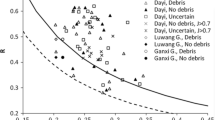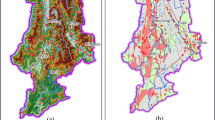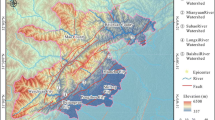Abstract
A channelized debris flow/flood generally originates from initial gully erosion by superficial runoff that evolves rapidly into massive erosion of the channel bed. Knowledge of the formation conditions of such events is crucial for accurate forecasting, and determination of rainfall and runoff thresholds for such hazards is a primary concern following a strong earthquake. This work proposed a framework for debris flow/flood formation at the watershed scale in two watersheds (area: 2.4 and 32.4 km2) in the Wenchuan Earthquake area (China). The critical runoff and rainfall conditions required for debris flow/flood formation were simulated and their annual variations investigated. Ultimately, the runoff conditions required for debris flow/flood formation in the two studied watersheds were calculated on an annual basis and found to increase in time. Similarly, following consideration of three different rainfall types, critical rainfall conditions were proposed that also showed an increasing tendency. The increase of rainfall and runoff conditions for debris flow/flood formation is attributable to both the recovery of vegetation and the reduction of source materials. In comparison with actual monitored flow behaviors and previously proposed rainfall thresholds, the results showed strong consistency and high forecasting efficiency.




















Similar content being viewed by others
References
Abanco C, Hurlimann M (2014) Estimate of the debris-flow entrainment using field and topographical data. Nat Hazards 71(1):363–383
Abanco C, Hurlimann M, Moya J, Berenguer M (2016) Critical rainfall conditions for the initiation of torrential flows. Results from the Rebaixader watershed (Central Pyrenees). J Hydrol 541:218–229
Aleotti P (2004) A warning system for rainfall-induced shallow failures. Eng Geol 73:247–265
Badoux A, Turowski JM, Mao L, Mathys N, Rickenmann D (2012) Rainfall intensity-duration thresholds for bedload transport initiation in small Alpine watersheds. Nat Hazards Earth Syst Sci 12(10):3091–3108
Bardou E, Jaboyedoff M (2008) Debris flows as a factor of hillslope evolution controlled by a continuous or a pulse process? Geol Soc Spec Publ 296:63–78
Berti M, Simoni A (2005) Experimental evidences and numerical modelling of debris flow initiated by channel runoff. Landslides 2(3):171–182
Berti M, Martina MLV, Franceschini S, Pignone S, Simoni A, Pizziolo M (2012) Probabilistic rainfall thresholds for landslide occurrence using a Bayesian approach. J Geophys Res 117:F04006
Bovis MJ, Jakob M (1999) The role of debris supply conditions in predicting debris flow activity. Earth Surf Process Landf 24(11):1039–1054
Brenna A, Surian N, Ghinassi M, Marchi L (2020) Sediment–water flows in mountain streams: Recognition and classification based on field evidence. Geomorphology 371:107413
Caine N (1980) The rainfall intensity-duration control of shallow landslides and debris flows. Geogr Annal Ser A Phys Geogr 62:23–27
Cannon S, Gartner J, Wilson R, Bowers J, Laber J (2008) Storm rainfall conditions for floods and debris flows from recently burned areas in southwestern Colorado and southern California. Geomorphology 96:250–269
Cavalli M, Trevisani S, Comiti F, Marchi L (2013) Geomorphometric assessment of spatial sediment connectivity in small Alpine catchments. Geomorphology 188:31–41
Church M, Jakob M (2020) What is a debris flood? Water Resour Res. https://doi.org/10.1029/2020WR027144
Coe JA, Glancy PA, Whitney JW (1997) Volumetric analysis and hydrologic characterization of a modern debris flow near Yucca Mountain Nevada. Geomorphology 20:11–28
Coe JA, Kinner DA, Godt JW (2008) Initiation conditions for debris flows generated by runoff at Chalk Cliffs, central Colorado. Geomorphology 96(3–4):270–297
Cui P, Chen XQ, Zhu YY, Su FH, Wei FQ, Han YS, Liu HJ, Zhuang JQ (2011) The Wenchuan Earthquake (May 12, 2008), Sichuan Province, China, and resulting geohazards. Nat Hazards 56(1):19–36
Cui YF, Zhou XJ, Guo CX (2017) Experimental study on the moving characteristics of fine grains in wide grading unconsolidated soil under heavy rainfall. J Mt Sci 14(3):417–431
Cui P, Guo XJ, Yan Y, Li Y, Ge YG (2018) Real-time observation of an active debris flow watershed in the Wenchuan Earthquake area. Geomorphology. 321(15):153–166
D'Agostino V, Michelini T (2015) On kinematics and flow velocity prediction in step pool channels. Water Resour Res 51:4650–4667
Dahal R, Hasegawa S (2008) Representative rainfall thresholds for landslides in the Nepal Himalaya. Geomorphology 100:429–443
Domènech G, Fan XM, Scaringi G, van Asch TWJ, Xu Q, Huang RQ, Hales TC (2019) Modeling the role of material depletion, grain coarsening and revegetation in debris flow occurrences after the 2008 Wenchuan earthquake. Eng Geol 250:34–44
Fan XM, Scaringi G, Korup O, West AJ, van Westen CJ, Tanyas H, Hovius N, Hales TC, Jibson RW, Allstadt KE, Zhang LM, Evans SG, Xu C, Li G, Pei XJ, Xu Q, Huang RQ (2019a) Earthquake-induced chains of geologic hazards: Patterns, mechanisms, and impacts. Reviews of Geophysics 57(2):421
Fan XM, Scaringi G, Domènech G, Yang F, Guo XJ, Dai LX, He CY, Xu Q, Runqiu Huang RQ (2019b) Two multi-temporal datasets that track the enhanced landsliding after the 2008 Wenchuan earthquake. Earth Syst Sci Data 11:35–55
Genevois R, Berti M, Ghirotti M, Simoni A, Tecca PR (1999) Debris flow monitoring and analysis in the Dolomitic region. Debris flow risk project of European Community—final report, vol. 2
Godt JW, Coe JA (2007) Alpine debris flows triggered by a 28 July 1999 thunderstorm in the central Front Range, Colorado. Geomorphology. 84(1-2):80–97
Gregoretti C (2000) The initiation of debris flow at high slopes: experimental results. J Hydraul Res 38(2):83–88
Gregoretti C, Dalla Fontana G (2008) The triggering of debris flow due to channel-bed failure in some alpine headwater basins of the Dolomites: analyses of critical runoff. Hydrol Process 22(13):2248–2263
Gregoretti C, Degetto M, Bernard M, Crucill G, Pimazzoni A, De Vido M, Berti M, Simoni A, Lanzoni S (2016a) Runoff of small rocky headwater watersheds: field observations and hydrological modeling. Water Resour Res 52(10):8138–8158
Gregoretti C, Degetto M, Boreggio M (2016b) Gis-based cell model for simulating debris flow runout on a fan. J Hydrol 534:326–340
Guo CX, Cui YF (2020) Pore structure characteristics of debris flow source material in the Wenchuan earthquake area. Eng Geol 267:105499
Guo XJ, Cui P, Li Y, Ma L, Ge YG, William BM (2016a) Intensity-duration threshold of rainfall triggering debris flows in Wenchuan earthquake area, China. Geomorphology 263:208–216
Guo XJ, Cui P, Li Y, Zou Q, Kong YD (2016b) The formation and development of debris flows in large watersheds after the 2008 Wenchuan Earthquake. Landslides. 13(1):25–37
Guo XJ, Cui P, Li Y, Fan JL, Yan Y, Ge YG (2016c) Temporal differentiation of rainfall thresholds for debris flows in Wenchuan earthquake-affected areas. Environ Earth Sci 75(2):1–12
Guo XJ, Cui P, Chen XV, Li Y, Zhang J, Sun YQ (2021) Estimation of discharges of water flows and debris floods in a small watershed. Earth Surf Process Landf. 10.1002/esp.5053
Guzzetti F, Peruccacci S, Rossi M, Stark C (2007) Rainfall thresholds for the initiation of landslides in central and southern Europe. Meteorog Atmos Phys 98:239–267
Guzzetti F, Peruccacci S, Rossi M, Stark C (2008) The rainfall intensity-duration control of shallow landslides and debris flows. an update. Landslides. 5:3–17
Han X, Chen J, Xu P, Zhan J (2017) A well-balanced numerical scheme for debris flow run-out prediction in Xiaojia gully considering different hydrological designs. Landslides 1:1–10
Hungr O, Evans SG, Hutchinson IN (2001) A review of the classification of landslides of the flow type. Environmental & Engineering Geoscience 7(3):221–238
Hungr O, Leroueil S, Picarelli L (2014) The Varnes classification of landslide types, an update. Landslides 11(2):167–194
Hurlimann M, Abanco C, Moya J, Raimat C, Luis-Fonseca R (2011) Debris-flow monitoring stations in the Eastern Pyrenees. Description of instrumentation, first experiences and preliminary results. In: Genevois R, Hamilton DL, Prestininzi A (eds) 5th international conference on debris-flow hazards mitigation: mechanics, prediction and assessment
Hürlimann M, Coviello V, Bel C, Guo X, Berti M, Graf C, Hübl J, Miyata S, Smith JB, Yin HY (2019) Debris-flow monitoring and warning: Review and examples. Earth Sci Rev 199:102981
Innes JL (1983) Debris flows. Progress in Physical Geography 7:469–501
Kean JW, Staley DM, Leeper RJ, Schmidt KM, Gartner JE (2012) A low-cost method to measure the timing of postfire flash floods and debris flows relative to rainfall. Water Resour Res 48:W05516
Marchi L, Arattano M, Deganutti AM (2002) Ten years of debris-flow monitoring in the Moscardo Torrent (Italian Alps). Geomorphology. 46(1):1–17
Mishra SK, Singh VP (2003) Soil conservation service curve number (SCS-CN) Methodology. Kluwer Academic Publishers, Dordrecht
Pastorello R, Hurlimann M, D`Agostino, V. (2018) Correlation between the rainfall, sediment recharge, and triggering of torrential flows in the Rebaixader watershed (Pyrenees, Spain). Landslides 15(10):1921–1934
Pastorello R, D'agostino, Hurlimann M (2020) Debris flow triggering characterization through a comparative analysis among different mountain watersheds. Catena. 186:104348
Rice CE, Kadavy KC, Robinson KM (1998) Roughness of loose riprap on steep slopes. J Hydraul Eng 124(2):179–185
SCS (1956) Hydrology. In: National Engineering Handbook, Supplement A, Section 4 Chapter 10, Soil Conservation Service. USDA, Washington
SCS (1985) Hydrology. In: National Engineering Handbook, Supplement A, Section 4 Chapter 4, Soil Conservation Service. USDA, Washington
Takahashi T (1978) Mechanical characteristics of debris flow. J Hydraul Div 104:1153–1169
Takahashi T (1991) Debris flow, Monograph of IAHR., AA Balkema Rotterdam
Tognacca C, Bezzola GR, Minor HE (2000) Threshold criterion for debris flow initiation due to channel bed failure. In: Wieczoreck GF (ed) Proceedings of the Second International Conference on Debris Flow Hazards Mitigation. Springer, Taipei, pp 89–97
Varnes DJ (1978) Slope movement types and processes. In: Schuster RL, Krizek RJ (eds) Landslides, analysis and control, special report 176: Transportation research board. National Academy of Sciences, Washington, pp 11–33
Wang G, Sassa K (2003) Pore-pressure generation and movement of rainfall-induced landslides: effects of grain size and fine-particle content. Eng Geol 69(1):109–125
Wei ZL, Xu YP, Sun HU, Xie W, Wu G (2018) Predicting the occurrence of channelized debris flow by an integrated cascading model: A case study of a small debris flow-prone watershed in Zhejiang Province, China. Geomorphology 308:78–90
Xu C, Xu X, Yao X, Dai F (2014) Three nearly complete inventories of landslides triggered by the May 12, 2008 Wenchuan Mw 7.9 earthquake of China and their spatial distribution statistical analysis. Landslides 11:441–461
Zhuang JQ (2011) Study the Mechanism of Debris Flow Based on Field Experiment Post Earthquake Envrionment. Ph.D Dissertation of Chinese Academy of Sciences (in Chinese)
Zhuang JQ, Cui P, Ge YG, Zhu YY, Liu YH, Pei LZ (2010) Risk Assessment of Collapses and Landslides Caused by 5.12 Wenchuan Earthquake—A Case Study of Dujiangyan-Wenchuan Highway. Chin J Rock Mech Eng 29(S2):3736–3742 (in Chinese)
Acknowledgements
This study was supported by the Strategic Priority Research Program of CAS (XDA20030301 and XDA23090202), National Research and Development Program (2017YFC1502504), NSFC (41977257), and Western Light of Young Scholars, CAS. We thank James Buxton MSc from Liwen Bianji, Edanz Group China (www.liwenbianji.cn/ac), for editing the English text of this manuscript.
Author information
Authors and Affiliations
Corresponding author
Rights and permissions
About this article
Cite this article
Guo, X., Li, Y., Chen, X. et al. Variation of debris flow/flood formation conditions at the watershed scale in the Wenchuan Earthquake area. Landslides 18, 2427–2443 (2021). https://doi.org/10.1007/s10346-021-01644-2
Received:
Accepted:
Published:
Issue Date:
DOI: https://doi.org/10.1007/s10346-021-01644-2




